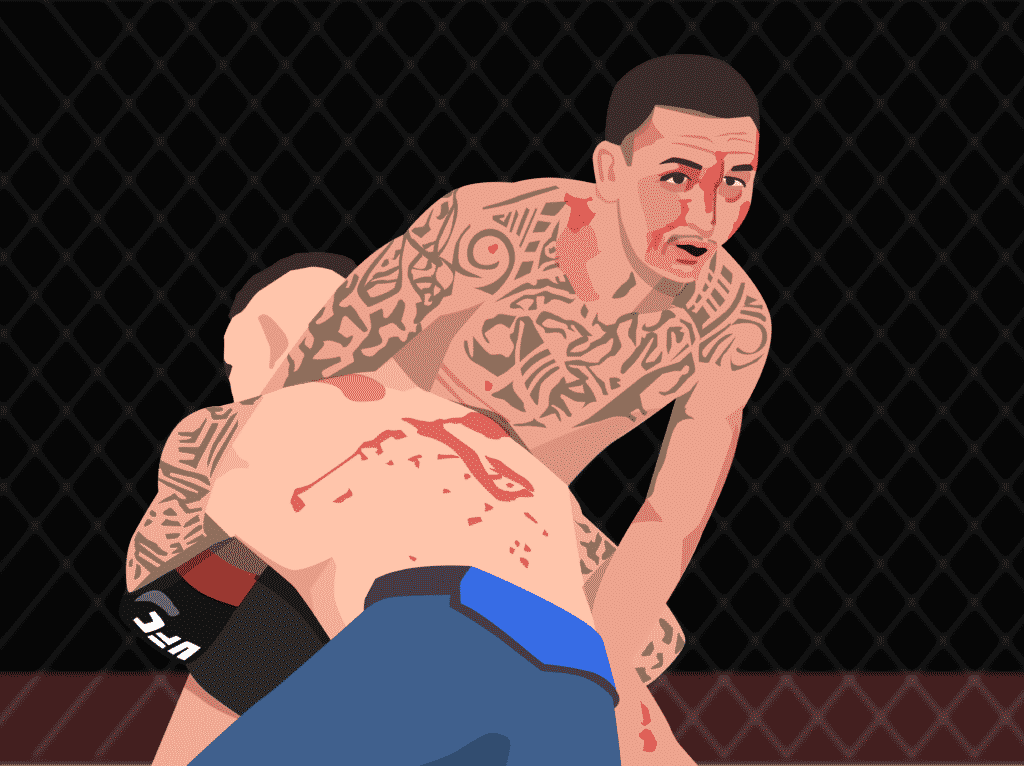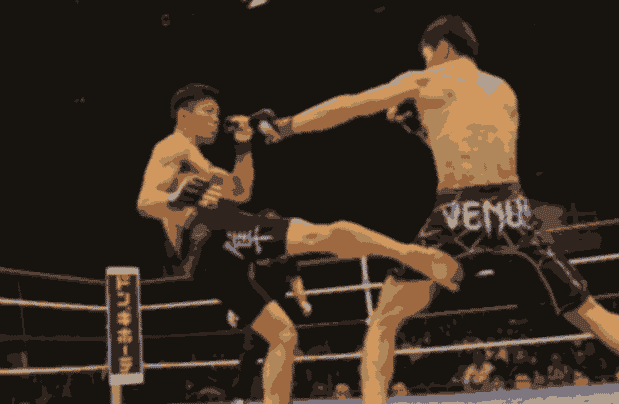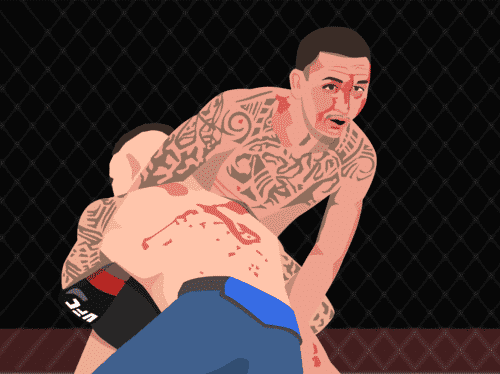With all this talk by the Ontario government to maximize boxing and mixed martial arts, I can’t help but look at how sport and society mesh. I also could not ignore concepts learned in a course I took called Sport Law when I saw this. Adding injury to insult (no pun intended), was highlights of UFC 236. Watching fighter Max Holloway get obliterated physically by Dustin Poirier on April 13, 2019 meant I had to try and justify why this type of violence is accepted in sport, but not in society. Or maybe I can’t justify it? Let’s see…

Background
It’s funny, when I was doing my sport management degree, my least favourite subject was Sports Law, and it was my least favourite by far.
My minor was based in Criminology and I had a deep interest in law and justice for years. So you would think that I would love to mix my two biggest passions. Nope, not at all.
It’s hard to believe that my two passions mixing wouldn’t engage me. Although I am telling you the truth, I guess it just wasn’t for me several years ago.
Meanwhile, it’s been years since I was a student. So, now I have a greater interest in sport law. Due to society’s awareness of brain injuries in sport, many leagues are getting tough on rules that relate to physical play. Yet, some do not really care about the impact of brain injuries. One of those not implementing changes to participant safety is the Ultimate Fighting Championship (UFC).
Perhaps the lack of brain and participant safety regulations comes due to the league’s name having the word fighting in it. Without fighting in the UFC, it probably wouldn’t exist and be worth, as claimed by UFC President Dana White, $7 billion.
One cannot ignore the message sent by the sports’ existence that fighting and bloodsport is okay. That’s where sport law comes in handy.
What is the UFC?
UFC is mixed martial arts. It falls into the realm of combat sports and involves one on one fighting. Indeed, one person fights another with the goal of “knocking them out” or getting them to submit to an excruciating, limp breaking submission hold. Fighters can also literally “choke out” their opponents cutting off the flow of blood to the brain with holds such as a guillotine front face-lock.
It’s like a mix of boxing and martial arts. Boxing it is like, in the sense that the fighters stand upright and punch one another. Also, martial arts, in the range of techniques used such as grappling and striking. For more on what mixed martial arts is, I suggest you take a read of my favourite, easy to read resource: Wikipedia.
UFC is far different than what it was when it debuted in 1993. The original UFC event was more like a tough man competition in which fighters from various styles competed in an open weight, one-night tournament.
The UFC evolved over the years with many of the innovations changing the exciting nature it held when it was first created. However, the changes have led to more of a streamlined league in which UFC is taken seriously by major sports media outlets like TSN, ESPN, and the BBC.
Think of the UFC as what boxing and professional wrestling were in the 1950s, 1960s, and 1970s. That was a time before boxing became fragmented and the wider population still believe pro wrestling wasn’t predetermined.

UFC fighters do get hurt. In fact, many of the fighters who battle in big-time fights spend weeks or even months healing. Keep in mind, the UFC isn’t just for men as the women’s division is similarly popular for fans to watch.
But again it needs to be said that sport law courses don’t have clearcut answers to whether violence leading to injury in the UFC is legal or not.
Full Disclosure: Do I watch it?
If I ever offer my take on a subject, there is always a counter, which is often, “do you even watch it”? So, I figure it would be best I come clean from the start. I must confess, I did semi-watch the so-called “Money Fight” in 2017. There was so much hype around it. Thus, I had to watch it for the sake of doing my job of being in touch with all sport. However, I am not an avid mixed martial arts fan, nor do I profess to watch each event. But I do look at the highlights briefly when an event takes place. The “Money Fight” wasn’t actually UFC or mixed martial arts. Floyd Mayweather and Conor McGregor took part in an exhibition boxing match rather than a UFC-style fight.
Assault
Let’s get into a little law discussion and relate it to sport, specifically the UFC. Physical assault in Canada is a crime. So, if A punches B on the street, A will likely be charged with assault. Then they will go to court for a trial.
Assault in Canada is when someone applies direct and/or indirect force to someone else. That’s what the UFC is all about. Applying force to someone else. In the UFC, doing an assault on someone else is a game plan, however. It’s revered by fans. Millions and sometimes billions of dollars are on the line for the league, team and fighters. So, it’s not a crime to destroy someone else in the UFC while it is if the same act was carried out away from the arena. In fact, if two individuals engaged in fisticuffs in the audience and one was badly injured, there would be consequences for the fight.
Why is that? Let’s turn to Sport Law for answers
It all comes down to consent and intent.
Consent
Did both parties agree to the fight? In the UFC and the other mixed martial arts fight leagues around the globe, indeed participants do. But what if someone on the street thinks you are looking at them the wrong way and says, “come at me bro” with a come-hither signal. Does this give you the legal right to “come at” them? I guarantee, if you hit them hard enough, you’ll end up in the bin for at least a night.
What’s more interesting is that injury does not even have to happen in order for an assault charge to ensue. Just the threat of injury is enough to warrant a charge for assault.
Violent acts that happen off the playing surface should be treated the same as those committed on the streets. That’s all in fairness.
Nonetheless, it seems like UFC fights can thwart the law. For instance, a post-match brawl between Conor McGregor and Khabib Nurmagomedov and their inner circle resulted merely in sanctions from the league. Innocent bystanders were put in harm’s way when the two fighters and their posses engaged in a knockdown, drag-out brawl.
Then how do you explain this UFC?
Governing Body’s Rules, Regulations and Policies
Since the UFC started in 1993, there have been opposing groups arguing far away from the octagon. One side argues that fighting is barbaric and leads to the legitimising of hand to hand combat. Which it does. UFC and other mixed martial arts fighters have been arrested numerous times for assaults. These have been both domestic assaults and brawls with people in public.
UFC does have rules when it comes to fights. Many of these are similar to boxing and dictate what a fighter can wear, how to win or lose, and manoeuvres that are not lawful. The fight league does have certain rules about how fighters can strike or areas they can strike. For instance, fighters cannot strike the back of the head, neck, and spine. Nor can fighters use the tip of the elbow.
However, the problem with these rules is their vagueness and the way referees implement them. For example, fighters are not allowed to use their heels to kick the kidney area, yet the liver area is not off limits. Of course, a lot of the action is up to the discretion of the referee, who is influenced by the UFC’s head honchos. They want to see the money roll in and fighters sacrificing themselves to accomplish the feat.
The Fight Build Up
The build-up of the fight is a theater for threats and intimidation. In this way, UFC is no different from professional wrestling. One fighter makes a claim or outlandish remark only for the other to fire back. This isn’t due to the fighters hating one another, but merely to sell more tickets or pay-per-view buys. The more they act like they dislike each other, the potential to make more money increases.
A UFC match can bring in millions of dollars if it is promoted correctly. Good promotion brings in money thanks to pay-per-view and ticket sales. It can also bring more money in further down the line if a fighter can continue their fighting win streak.
Conor McGregor is one of the best examples of how a fighter can increase the money made by UFC. The Irish fighter could talk people into the watching the UFC and many times back it up in the octagon. It is his ability to talk that made his boxing match against Floyd Mayweather a must-see event that brought in $300 million.
Why do people love the UFC?
It is a difficult question for people to really answer just why they like UFC. Some love to see two people compete in sporting contest. Others see the sport for its tactics and planning. The truth is the UFC legitimizes fighting, violence, and hurting each other. The UFC is seducing but it is difficult to ignore the violence that takes place inside the octagon and maybe the violence is what really turns people on to watch it.
Mixed martial arts draws a variety of people to watch it. Look at the various people in attendance of a UFC event and you will find what looks like middle and upper-middle class fans. The sport also appeals to fans of lower incomes which can be seen at the sports bars that show the fights live on television. UFC has the ability to draw fans from various economic backgrounds, educations, and genders.
UFC isn’t the only fight game in town. Bellator is the fight league’s main competitor. Although Bellator’s fighters are not seen as good as the UFC’s, the league is an alternative. It is very similar in the end, however.
In recent years, UFC has influenced an influx of television channels in North America showing big time boxing. From ESPN to DAZN, more television channels are showing combat sports. The mainstream is more open than ever to combat sports and violence. Of course, you can just turn on the television and see the violence on the average television show to see how violence is widely accepted in modern culture..
UFC isn’t going anywhere
No matter your stance on UFC, boxing, or other combat sports, they are not going anywhere. The United States government and former congressman John McCain attempted to fight the UFC, but he couldn’t stop the sport.
The UFC is worth $7bn and the fight promotion has everything from apparel deals to video games. It is a sports league that rivals the likes of the NHL, Major League Soccer, and other non-top three North American sports leagues (NFL, NBA, MLB).
Combat sports is a growing industry. Gyms around the world are dedicated to it and major media outlets now report on UFC. Media groups such as the BBC, who once refused to legitimize mixed martial artist, now cover it with column inches.
You may not legally get away with putting a person in a triangle choke on the street or giving them a running knee; but you can in the octagon. The world has legitimized UFC as a sport and in many ways the NFL and tackling on the gridiron has had the same thing done to it.
Will I begin watching UFC and following it? Probably not as it just doesn’t attract me due to the violence but there are plenty of others who are okay with it. But whenever I see UFC highlights, I’ll never forget the concepts many forget about from sport law discourse.

